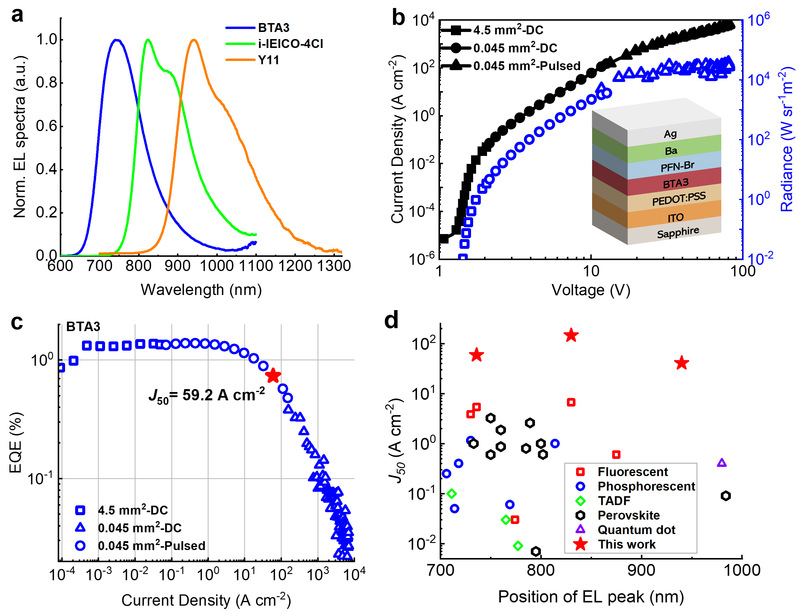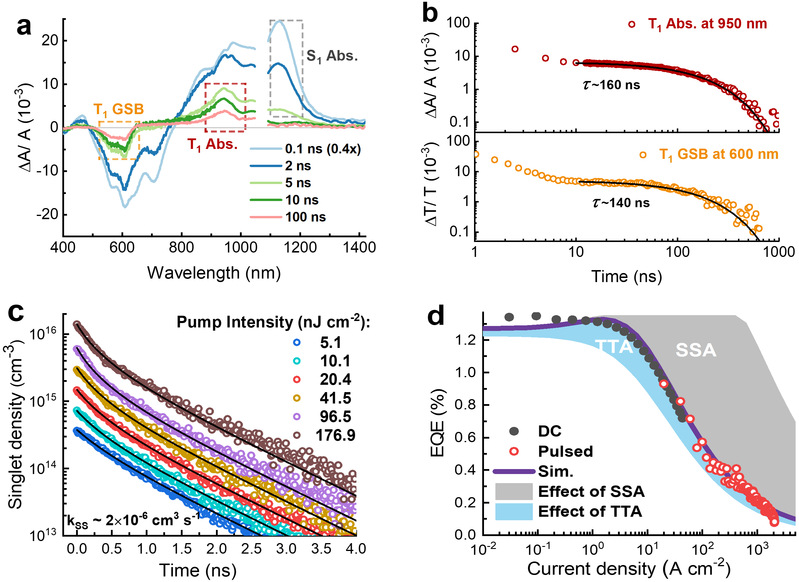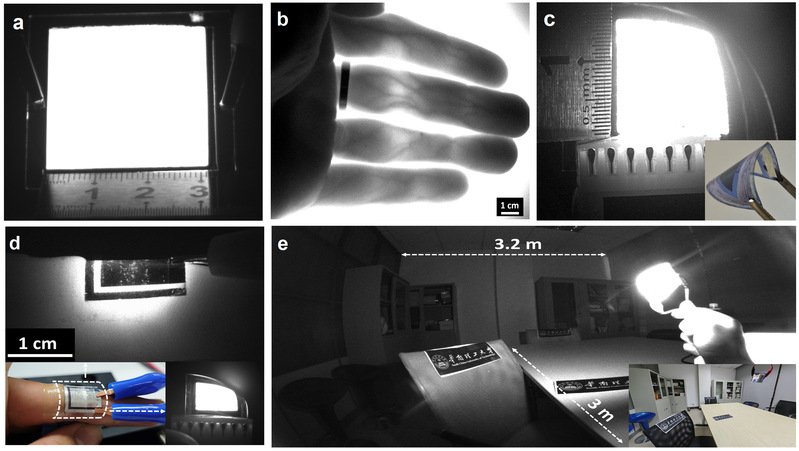Recently, Professor Wu Hongbin's research group published a research paper titled Ultra high radiance near infrared organic light emitting diodes in the internationally renowned journal Nature Photonics. This paper proposes a new strategy to suppress the efficiency roll off of organic light-emitting diodes. By reducing the quenching of singlet excitons by long-lived triplet excitons, the critical current density of the device under DC and pulse driving is increased to the order of 100 A/cm2 and 10 kA/cm2, respectively, achieving ultra-high brightness near-infrared electroluminescence with a brightness 147 times higher than that of surface solar radiation.

The research results of the research group were published in the journal Nature Photonics
The luminescence in the near-infrared band (700-1700 nm) has a wide range of applications in traditional fields such as sensing, optical communication, industrial quality control, and safety protection. Due to its low scattering and deep penetration characteristics in living organisms or tissues, it has broad application prospects in optical coherence tomography technology, biochemical information acquisition such as blood oxygen/blood glucose, facial/iris/fingerprint biometric recognition, and other fields. At the same time, organic semiconductor light sources have outstanding advantages such as abundant material sources, simple preparation processes, low costs, and biocompatibility. They also have a tunable spectral range, large spectral full width at half maximum, and low temporal coherence, making them an ideal light source for non-invasive, wearable, and implantable electronic devices such as blood oxygen/glucose meters, photo biological modulation, and optical phase imaging.
Although organic light-emitting materials with emission wavelengths in the near-infrared range have broad application scenarios, currently reported organic near-infrared light-emitting diodes (OLEDs) still face disadvantages such as low quantum efficiency, low radiation power, and short lifespan. Especially limited by the many annihilation and competitive loss processes between excitons or charge carriers within the device, the current efficient and bright near-infrared organic light-emitting diodes that meet practical application scenarios still face great difficulties. There is an urgent need for new material systems and technological pathways to achieve high brightness near-infrared organic light-emitting diodes.
The researchers selected donor acceptor donor (A-D-A) type fused ring electron acceptors (BTA3, i-IEICO-4Cl, Y11) with high transition oscillator strength and high luminescence efficiency as luminescent materials. By combining the thermal management of the system and optimizing the carrier injection strategy, the maximum external quantum efficiency of the BTA3 based electroluminescent device reaches 1.34%. The device exhibits extremely low efficiency roll off characteristics, maintaining performance comparable to maximum efficiency within a current density range of 6 orders of magnitude. When it drops to half of its maximum value, the corresponding critical driving current J50 reaches 59 A cm-2, far exceeding other types of semiconductor materials (Figure 1). In continuous DC driving mode, the maximum operating current density of the device reaches over 100 A/cm2. In pulse driving mode with a pulse width of 1 us, the maximum operating current density reaches the level of 10 k A/cm2, and a record breaking 46786 W Sr-1 m-2 radiance is achieved, which is equivalent to 147 times the intensity of surface solar spectral radiation.

Figure 1. (a) Electroluminescence spectrum of the device. (b) The current density voltage emissivity characteristics of BTA3 devices. (c) The external quantum efficiency current density characteristics of the device. (d) Comparison of critical driving current density levels for different types of near-infrared light-emitting devices in literature reports.
To verify the ultra-high current density working mechanism of the device, researchers designed a series of experiments to explore the relevant characteristics of materials and devices. Through the study of transient absorption spectroscopy and exciton annihilation dynamics based on time-resolved techniques, researchers found that the lower triplet energy level and short triplet exciton lifetime (0.13 s) of BTA3 molecule effectively avoid the accumulation of triplet excitons, thereby greatly slowing down the impact of singlet triplet annihilation on efficiency roll off (Figure 2). The larger triplet exciton diffusion length promotes the triplet triplet annihilation process, which is beneficial for improving exciton utilization and alleviating efficiency roll off. The study also found that the enhanced molecular rigidity and planarity of A-D-A type molecules enhance resonance energy transfer, and the regulation of molecular stacking reduces the energy disorder of the system, promoting the diffusion of singlet excitons. The computational simulation also shows that when the current density of the device is too high (greater than 10 A/cm2), singlet singlet annihilation becomes the dominant factor in the efficiency roll off of the device, indicating that in order to achieve higher operating current density and realize electrically pumped organic laser diodes, it is necessary to focus on suppressing the singlet singlet annihilation process.

Figure 2. (a) Transient absorption spectrum of infrared luminescent material BTA3 in solution state. (b) The lifetime of triplet excitons extracted through single exponential fitting (approximately 140-160 ns). (c) Pump intensity dependent singlet exciton decay curve. (d) Efficiency roll off characteristics and dynamic simulation of organic near-infrared light-emitting devices.
Researchers designed and fabricated high-power devices with an area of 10 cm2, as well as flexible substrate based bendable surface light sources, and demonstrated their applications in active night vision lighting, non-invasive biological imaging, and biomedical applications closely adhered to the human body (Figure 3).

Figure 3. (a) Physical photos of 10 cm2 near-infrared OLEDs developed during the pre research stage, and (b) Transmission imaging of human finger blood vessels. (c) Demonstration of a 1.5 × 1.5 cm2 bendable surface light source and (d) wearable OLED patch concept based on flexible substrate manufacturing. (e) Examples for indoor active night vision lighting and other applications.
Dr. Liu Wansheng is the first author of this research work, while Professor Xie Yuan and Professor Wu Hongbin are the corresponding authors of the paper. This study received support from Professor Peng Junbiao's team, Professor Zhao Zujin's team, and Academician Cao Yong from South China University of Technology, as well as assistance from Gao Chao's research team at Xi'an Institute of Modern Chemistry, Professor Ji Yun from City University of Hong Kong, Professor Duan Lian from Tsinghua University, Professor Zhan Xiaowei from Peking University, and Professor Zou Yingping from Central South University. The research work has received funding from key research and development projects of the Ministry of Science and Technology, the Postdoctoral Innovation Talent Support Program of the Ministry of Human Resources and Social Security, key projects and general projects of the National Natural Science Foundation of China, as well as full-time researcher projects of schools and colleges.
Paper link: https://www.nature.com/articles/s41566-025-01674-5



